
(Vienna, 07 June 2022) Activating a circuit between the amygdala and brainstem relieves pain and reduces defensive behaviors in rats, according to a study recently published in the Journal of Neuroscience by a study team at MedUni Vienna's Center for Brain Research. Therapeutic activation of this signaling pathway could provide pain patients with physical and psychological relief in the future.
People with pain often experience psychological comorbidities like anxiety and depression, which can end up making their prognosis worse. A pathway from the amygdala to a nucleus in the brainstem may offer a way to treat pain’s toll on both the body and the mind. A study team headed by Roni Hogri in Jürgen Sandkühler's research group in the Department of Neurophysiology at MedUni Vienna's Center for Brain Research activated the circuit in rats and measured their response to chemical, mechanical, and thermal pain stimuli. Stimulating the circuit decreased the brainstem’s response to all three stimuli, indicating pain relief. In a separate situation, stimulating the circuit decreased the rats’ defensive behaviors in response to a threat. It also increased reward and feeding behavior, a sign the rats felt safe. The combination of these behavior changes indicates the circuit steers rats out of a negative emotional state and into a positive one.
In humans, there is not yet a way to stimulate a specific brain circuit. Existing brain stimulation technologies are not precise enough and could activate neighboring circuits that could increase pain and negative emotions. But addressing these technical roadblocks could lead to a treatment that addresses both the pain itself and the negative feelings it generates.
Publication: Journal of Neuroscience
GABAergic CaMKIIα+ amygdala output attenuates pain and modulates emotional-motivational behaviour via parabrachial inhibition
Roni Hogri, Hannah Teuchmann, Bernhard Heinke, Raphael Holzinger, Lidia Trofimova, and Jürgen Sandkühler;
J. Neurosci., 42(27):5373–5388
DOI: https://doi.org/10.1523/JNEUROSCI.2067-21.2022